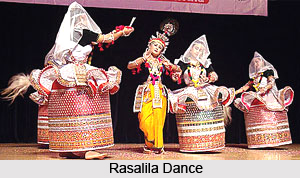 Costumes in Rasalila dance are vibrant in colour and are made to look gorgeous with heavy ornamental pieces. However, the costume of rasalila greatly varies according to the dance styles. If rasalila is performed in its traditional form, the costumes reflect Krishna Gopi style with a gorgeous dhoti for the main dancer and typical ornamental ghagras for the Gopis. Rasalila is often performed in Manipuri dancing style, the Krishna dancer dresses in bright coloured dhoti with jewellery and the Gopis dress in the emblematic drum style costumes.
Costumes in Rasalila dance are vibrant in colour and are made to look gorgeous with heavy ornamental pieces. However, the costume of rasalila greatly varies according to the dance styles. If rasalila is performed in its traditional form, the costumes reflect Krishna Gopi style with a gorgeous dhoti for the main dancer and typical ornamental ghagras for the Gopis. Rasalila is often performed in Manipuri dancing style, the Krishna dancer dresses in bright coloured dhoti with jewellery and the Gopis dress in the emblematic drum style costumes.
The cult of Radha and Krishna or the rasalila, is central to its themes and the dances incorporate the double-headed drum (pung or Manipuri mridang) of sankirtan; characteristic cymbals (kartal or manjira) into the visual performance while performing in Manipuri style. The traditional rasalila dance operas are centred on the heavenly dance of Lord Krishna amusing himself with his milkmaids. The costumes of Ras Lila of Manipur are bright and are quite captivating to look at. The costume of this type of dance makes the entire performance even more spectacular. The splendid acts of the dancers complement their costumes. The richness of the costumes, the composure, the melodious music and the dedication with which Ras Lila is performed assures to strike an emotional chord.
The Natya Shastra describes `ras` and `rasak` as minor forms of drama, but today the meaning is more specific that refers to dance of Krishna with the gopis of Vrindaban, thus the costumes also strictly adhere to the Vrindavan style of dressing. The costumes used in this dance are embellished with metallic designs that make them more prominent on the stage. Since the music is slow as well as rhythmic, the costumes are well blended with the dance forms, thus, not exaggerating their soothing outlines. The costume of Rasalila deals with the creation of the world, while the dance performance deals with the intimacy between Krishna and his consort - Radha. A large variety of elaborate rhythmic patterns are played on the instruments like drums and cymbals. Usually, all the Gopis dress alike; Radha dresses more affluently to stand apart. Coloured garlands and other shimmering paper jewelleries also adorn the dancers on stage. The headgear of Krishna is usually an elongated one as compared to Radha and other Gopis. The face make up is quite heavy that helps the dancers to clarify their expressions.
Much of the tradition of sixteenth-century Vaishnavism has been preserved in the rasalila dance form. The numerous Radha-Krishna sculptures show the same structure of presentation and the same costumes as are worn today, namely ghaagra, choli and dupatta for women and dhoti for men. Even the language of the rasalila songs has a sixteenth-century flavour, and the similes used give an insight into the social conditions of those times. Rasalila is performed in a mandap; this arena is decorated beautifully with green leaves, flowers and white cloth. The religious impact of Rasa Lila is set on purely aesthetic grounds. This dance form is incredibly moving and exhilarating spectacle, striking an emotional chord which makes it worldwide in its appeal.



















